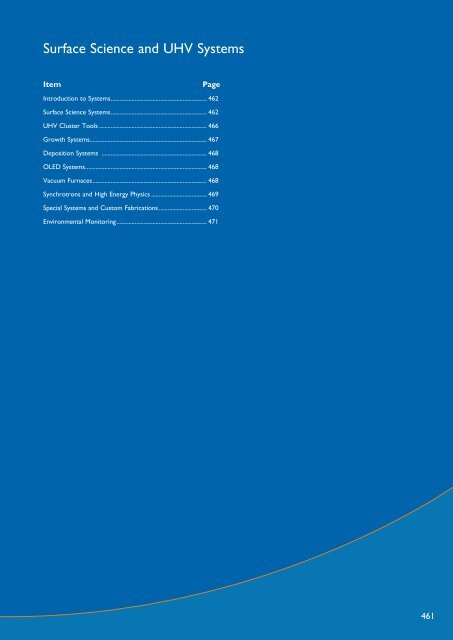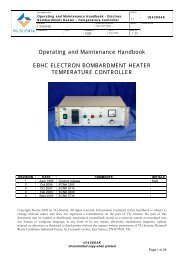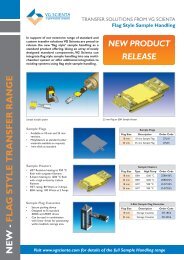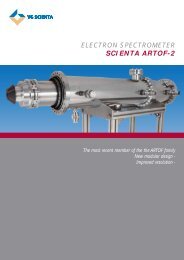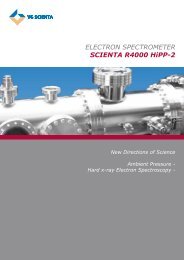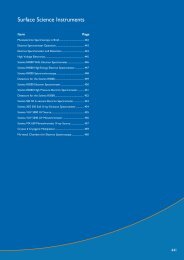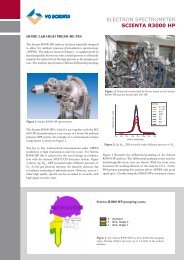Surface Science and UHV Systems - VG Scienta
Surface Science and UHV Systems - VG Scienta
Surface Science and UHV Systems - VG Scienta
Create successful ePaper yourself
Turn your PDF publications into a flip-book with our unique Google optimized e-Paper software.
<strong>Surface</strong> <strong>Science</strong> <strong>and</strong> <strong>UHV</strong> <strong>Systems</strong><br />
Item Page<br />
Introduction to <strong>Systems</strong> ................................................................ 462<br />
<strong>Surface</strong> <strong>Science</strong> <strong>Systems</strong> ................................................................ 462<br />
<strong>UHV</strong> Cluster Tools ........................................................................ 466<br />
Growth <strong>Systems</strong> .............................................................................. 467<br />
Deposition <strong>Systems</strong> ...................................................................... 468<br />
OLED <strong>Systems</strong> ................................................................................. 468<br />
Vacuum Furnaces ............................................................................ 468<br />
Synchrotrons <strong>and</strong> High Energy Physics ..................................... 469<br />
Special <strong>Systems</strong> <strong>and</strong> Custom Fabrications ................................ 470<br />
Environmental Monitoring ............................................................ 471<br />
461
<strong>Systems</strong><br />
Introduction to <strong>VG</strong> <strong>Scienta</strong> <strong>Systems</strong><br />
General<br />
<strong>VG</strong> <strong>Scienta</strong> has over forty years’ experience in<br />
the conception, design <strong>and</strong> manufacturing of<br />
st<strong>and</strong>ard <strong>and</strong> special vacuum systems for scientific<br />
use We have extensive expertise in ultra<br />
high vacuum seals, sample h<strong>and</strong>ling, sample<br />
preparation, heating <strong>and</strong> cooling, gas h<strong>and</strong>ling<br />
<strong>and</strong> growth techniques. This makes <strong>VG</strong> <strong>Scienta</strong><br />
uniquely positioned to help you from the concept<br />
stage of your system through design,<br />
manufacturing <strong>and</strong> installation of the system on<br />
your site.<br />
<strong>VG</strong> <strong>Scienta</strong> has in-house technical <strong>and</strong> design<br />
skills that will work with you to design your system<br />
on advanced a 3D CAD which will model<br />
your system to ensure that the design meets your<br />
requirements. We will help you design the electronic<br />
controls to allow anything from a complete<br />
manual system to a fully automatic one.<br />
Once the design has been signed off, <strong>VG</strong> <strong>Scienta</strong><br />
will manufacture the chambers, components <strong>and</strong><br />
all key parts of the system in house <strong>and</strong> control<br />
the process at all stages of the system build. In<br />
our systems area we will assemble <strong>and</strong> test you<br />
system to vacuum specifications, ensure sample<br />
h<strong>and</strong>ling <strong>and</strong> control work <strong>and</strong> test for any other<br />
agreed test criteria.<br />
<strong>Surface</strong> <strong>Science</strong> <strong>Systems</strong><br />
<strong>VG</strong> <strong>Scienta</strong> is the leading supplier of state-ofthe-art<br />
electron spectroscopy equipment. We<br />
offer ultra high resolution electron spectrometers<br />
for XPS, UPS <strong>and</strong> ARPES, high intensity<br />
UV <strong>and</strong> X-ray sources as well as tailor made mumetal<br />
chambers <strong>and</strong> dedicated sample manipulation<br />
solutions for electron spectroscopy. <strong>VG</strong><br />
<strong>Scienta</strong> can integrate all these components into<br />
advanced surface science systems customised to<br />
your requirements. In 1989 we introduced our<br />
first ESCA 300 system <strong>and</strong> <strong>VG</strong> <strong>Scienta</strong> has since<br />
then worked with customers to put together<br />
some of the most advanced systems for synchrotron<br />
<strong>and</strong> lab research.<br />
462 www.vgscienta.com
Customized XPS <strong>Systems</strong> for<br />
Laboratories <strong>and</strong> Synchrotrons<br />
<strong>VG</strong> <strong>Scienta</strong> is uniquely positioned to provide<br />
customised solutions for surface analysis systems.<br />
With in-house expertise <strong>and</strong> control of the<br />
design <strong>and</strong> manufacturing of sources, analysers<br />
<strong>and</strong> vacuum system, <strong>VG</strong> <strong>Scienta</strong> can meet the<br />
most challenging customer requirements. We<br />
cooperate closely with our customer in specifying<br />
<strong>and</strong> designing the system to ensure that<br />
it meets the final requirements. <strong>VG</strong> <strong>Scienta</strong>’s<br />
expertise in sample transfer ensures that we can<br />
integrate surface science solutions to existing<br />
systems.<br />
www.vgscienta.com<br />
<strong>Surface</strong> <strong>Science</strong> <strong>Systems</strong><br />
UPS <strong>Systems</strong> for Laboratories <strong>and</strong><br />
Synchrotrons<br />
UPS is one of the most useful tools to study the<br />
valence b<strong>and</strong> structure. Photons from <strong>VG</strong><br />
<strong>Scienta</strong>’s high power UV source are used to<br />
bombard a surface. Emitted electrons from the<br />
surface are analysed in a hemispherical analyser<br />
which provides an energy spectrum which gives<br />
information about the states of electrons in<br />
atoms <strong>and</strong> chemical bondings.<br />
Along with the high-powered UV source, <strong>VG</strong><br />
<strong>Scienta</strong> provides an easy-to-use UV monochromator<br />
enabling the user to tune between He I<br />
<strong>and</strong> He II radiation.<br />
<strong>VG</strong> <strong>Scienta</strong> can provide a custom designed surface<br />
science system <strong>and</strong> maximise the performance<br />
through careful design <strong>and</strong> consideration<br />
of the sample h<strong>and</strong>ling <strong>and</strong> chamber. During the<br />
design process <strong>VG</strong> <strong>Scienta</strong> consider the magnetic<br />
shielding <strong>and</strong> vacuum requirements for all<br />
electron spectroscopy applications.<br />
<strong>Systems</strong><br />
463
<strong>Systems</strong><br />
<strong>Surface</strong> <strong>Science</strong> <strong>Systems</strong><br />
ARPES <strong>Systems</strong> for Laboratories <strong>and</strong><br />
Synchrotrons<br />
From the late 1980s, angle resolved photo emission<br />
spectroscopy (ARPES) has been intensively<br />
applied to probe the quasi particle <strong>and</strong> anisotropic<br />
superconducting gap below the Fermi<br />
level for high Tc superconductors.<br />
ARPES has proved to be a powerful technique<br />
to reveal Fermi surface details. It is used for<br />
studies of materials such as superconductors<br />
(SC), colossal magnetoresistive (CMR) oxides,<br />
non-linear optical (NLO) crystals, charge density<br />
wave (CDW) compounds <strong>and</strong> metal-insulator<br />
transition (MIT) systems.<br />
In the summer of 1993, <strong>Scienta</strong> delivered the<br />
first SES 200 electron analyser to Stanford<br />
University. Due to its capability of measuring<br />
kinetic energy <strong>and</strong> momentum of photoelectrons<br />
with high energy <strong>and</strong> angular resolutions,<br />
this analyser simplified ARPES experiments<br />
dramatically.<br />
Since then, <strong>Scienta</strong> has developed the SES<br />
100, SES 2002 <strong>and</strong> SCIENTA R4000 electron<br />
spectrometers. For the SCIENTA R4000, a<br />
wide-angle lens has been specifically designed<br />
for angular-resolved measurements, reaching<br />
angular resolution within ± 15 degrees simultaneously.<br />
Material researchers of electronic structures <strong>and</strong><br />
magnetic properties could use an ARPES system.<br />
ARPES makes b<strong>and</strong> mapping possible as<br />
another experimental parameter is introduced,<br />
that is the momentum vector of the photoelectron.<br />
When the photoelectrons are emitted<br />
from the sample surface, not only energy can be<br />
measured but also the angles relative to crystal<br />
axis of the sample. From the angle <strong>and</strong> energy<br />
the momentum of the electrons can be determined.<br />
If the energy distribution <strong>and</strong> momentum<br />
distribution of the electrons are known, the<br />
b<strong>and</strong> structure of the crystal can be determined.<br />
A <strong>VG</strong> <strong>Scienta</strong> system with a high resolution<br />
<strong>Scienta</strong> R3000 or R4000 analyser is ideally suited<br />
for this kind of research.<br />
464 www.vgscienta.com
HEXPS <strong>Systems</strong><br />
In resent years the interest in high-energy XPS<br />
(HEXPS) has grown significantly. The R4000<br />
analyzer from <strong>VG</strong> <strong>Scienta</strong> has the ability for<br />
High Energy XPS (HEXPS). The R4000 can be<br />
specified on request to work up to 10 keV. This<br />
extended energy range allows scientists to probe<br />
deeper into the sample <strong>and</strong> allows work to be<br />
extended to the Fe 1s levels, facilitating unique<br />
research of steel metals.<br />
High Pressure XPS <strong>Systems</strong><br />
All hemispherical analyzers from <strong>VG</strong> <strong>Scienta</strong><br />
have the ability to be set up for higher pressure<br />
applications. X-ray photoemission spectroscopy<br />
(XPS) can be powerful method to<br />
study gas-solid interaction, catalysis reaction on<br />
the solids <strong>and</strong> biological samples, especially in<br />
environmental research. <strong>VG</strong> <strong>Scienta</strong> is working<br />
closely with the research community to improve<br />
techniques <strong>and</strong> develop systems that enable near<br />
ambient pressure, or high-pressure, XPS/UPS<br />
studies to be made.<br />
www.vgscienta.com<br />
<strong>Surface</strong> <strong>Science</strong> <strong>Systems</strong><br />
<strong>Systems</strong><br />
465
<strong>Systems</strong><br />
<strong>UHV</strong> Cluster Tools<br />
Introduction to R2P2 Cluster Tools<br />
The R2P2 cluster tool is a development of the<br />
linear rack <strong>and</strong> pinion transporter, where a single<br />
ended rack <strong>and</strong> pinion can be rotated within a<br />
circular vessel until it is aligned in a preset position<br />
at a radial port on the housing chamber by<br />
a rotary drive.<br />
Once locked in position, the same rotary drive<br />
moves the rack out through the port. R2P2s are<br />
normally mounted at the centre of a series of<br />
chambers <strong>and</strong> form a central hub from which<br />
all of the transfer takes place; they can be also<br />
used to join one or more systems together. The<br />
R2P2 chamber is normally connected by isolation<br />
valves to each of the connecting chambers<br />
allowing it to be sealed off as required. Careful<br />
design can allow storage carousels to be placed<br />
inside the chamber to allow sample storage as<br />
well as transfer to <strong>and</strong> from vessels.<br />
A port mounted at the base of the R2P2 allows<br />
a pump to maintain the chamber at a pressure<br />
lower than 10 -10 mbar if required.<br />
The XLTL series of linear transfer devices are<br />
rack <strong>and</strong> pinion drives based on the RLRP transfer<br />
arm. This has an NW35CF (70 mm OD)<br />
mounting flange <strong>and</strong> is available in a range of<br />
travels from 305 mm to 914 mm. The secondary<br />
motion of the RLRP is used to disengage the<br />
carrier from the transfer arm.<br />
The basic transfer arm, the XLTLB, can be supplied<br />
with an extension sleeve to bring the secondary<br />
movement close to the mounting port.<br />
This is recommended for long travels. A spring<br />
release extension sleeve with limit stops can be<br />
supplied for additional security.<br />
The XLTR radial transfer mechanism is based<br />
on the innovative R2P3 device. This is positioned<br />
as the hub of the system chambers which<br />
are located around the XLTR. Samples can then<br />
be distributed radially from the entry lock into<br />
the process, preparation <strong>and</strong> analysis chambers<br />
<strong>and</strong> so on. This has the advantage that a single<br />
device can be used for all sample transfer<br />
requirements.<br />
The XLRD series of linear transfer devices are<br />
magnetically coupled <strong>and</strong> based on our MLRD<br />
range of drives. This is a lower cost option than<br />
the XLTL version but does not offer the same<br />
sample security as the XLTL <strong>and</strong> XLTLSS combination.<br />
466 www.vgscienta.com
Growth <strong>Systems</strong><br />
Compact growth <strong>and</strong> analysis facility installed<br />
at the Japanese photon factory at Tskuba city.<br />
The analysis chamber is connected to an x-ray<br />
beam line <strong>and</strong> is fitted with a five axis manipulator<br />
for RVLEED <strong>and</strong> fluorescent EXAFS<br />
studies using a solid state multi-detector array<br />
with a <strong>UHV</strong> chamber. This detector is also used<br />
in conjunction with a high resolution six axis<br />
goniometer for fluorescent SEXAFS. <strong>Surface</strong><br />
x-ray diffraction experiments use a channelplate<br />
detector which rotates on the six axis goniometer.<br />
Cassettes of samples are entered through<br />
the loadlock <strong>and</strong> into the transfer, preparation<br />
<strong>and</strong> storage chamber. The deposition chamber<br />
is fitted with an e-gun <strong>and</strong> two K-cells to allow<br />
epitaxial growth of semiconductors.<br />
Deposition chamber.<br />
Phocathode preparation system.<br />
www.vgscienta.com<br />
Growth <strong>and</strong> analysis facility.<br />
<strong>UHV</strong> high TC growth system.<br />
Growth <strong>Systems</strong><br />
Thin Film Growth<br />
True <strong>UHV</strong>, 5 x 10 -11 mbar, high Tc superconductor<br />
thin film growth facility supplied to the<br />
University of Delft featuring two 40cc e-guns,<br />
three x 40cc PBN K-cells <strong>and</strong> oxygen resistant<br />
sample heating. The system is equipped with<br />
quadrupole rate controllers <strong>and</strong> a five specimen<br />
cassette entry lock system. It has since been<br />
upgraded to include a surface analysis facility.<br />
Sample Growth<br />
Substrate manipulators for large samples, (50-<br />
150 mm diameter), available with or without<br />
continuous sample rotation.<br />
The tantalum foil radiant elements are capable<br />
of heating wafers up to 850 ºC without a sample<br />
shutter, <strong>and</strong> 1200 ºC with a shutter. Also available<br />
with Z shift, <strong>and</strong> oxygen resistant versions.<br />
<strong>Systems</strong><br />
467
<strong>Systems</strong><br />
Deposition <strong>Systems</strong> <strong>and</strong> Vacuum Furnaces<br />
Sputter deposition system.<br />
OLED Edge system.<br />
Internal hot zone<br />
Deposition <strong>Systems</strong><br />
We can produce a range of deposition systems<br />
for development through to small scale productions<br />
units, with sputter sources, electron beam<br />
sources <strong>and</strong> thermal evaporation cells. We have<br />
extensive expertise in producing systems from<br />
single chamber deposition systems to combine<br />
deposition thermal treatment <strong>and</strong> surface analysis<br />
units where we can look after all the transportation,<br />
vacuum, <strong>and</strong> interface issues. The range<br />
of systems available include small scale MBE,<br />
OLED, sputtering <strong>and</strong> electron beam systems,<br />
these can be delivered as complete turn key<br />
units to components for self assembly to fit the<br />
budgets available.<br />
OLED <strong>Systems</strong><br />
<strong>VG</strong> <strong>Scienta</strong> offer the OLED Edge research <strong>and</strong><br />
development system. This system has a proven<br />
track record in the development field of OLED<br />
production, <strong>and</strong> is a fully flexible unit configured<br />
around a central distribution system.<br />
The whole OLED Edge system is completely<br />
modular allowing initial purchase of basic deposition<br />
units through to multi chamber systems<br />
with characterisation <strong>and</strong> analysis units included.<br />
The OLED Edge can be supplied as either a<br />
turnkey system mated to glove boxes, or as a self<br />
build unit, with the assurance that it will function<br />
from day one.<br />
Ultra High Vacuum Furnaces<br />
Ultra high vacuum furnaces are controlled to<br />
give complete thermal/vacuum cycling from a<br />
single push button operation. The furnaces can<br />
be supplied with gas quench facility. By applying<br />
our knowledge at <strong>VG</strong> <strong>Scienta</strong> we can guarantee<br />
clean, hydrocarbon-free environments at pressures<br />
better than 10-6 mbar at 1400 ºC. St<strong>and</strong>ard<br />
configurations offer hot zones up to 600 mm<br />
in diameter x 800 mm high <strong>and</strong> temperature<br />
ranges up to 1850 ºC (105 mm diameter x 140<br />
mm high).<br />
468 www.vgscienta.com
The vacuum chambers illustrated here are the<br />
dipole/crotch assemblies that form a major part<br />
of the diamond storage ring at the Rutherford<br />
Appleton Laboratory in the UK. The storage<br />
ring dipole bending magnets bend the trajectory<br />
of the electrons <strong>and</strong> force them to circulate<br />
in a closed orbit inside the vacuum chambers.<br />
The crotch vessels allow the electron beam to<br />
continue in a straight trajectory after the dipole<br />
magnet whilst at the same time allowing the<br />
synchrotron radiation, from either the dipoles or<br />
insertion devices, to pass down the beamline to<br />
the experimental station.<br />
The vessels had to be manufactured to very<br />
tight tolerances to ensure correct positioning of<br />
the electron <strong>and</strong> x-ray beams, <strong>and</strong> to allow the<br />
chambers to fit into the polepieces of the dipole<br />
bending magnets <strong>and</strong> the quadrupole <strong>and</strong> sextupole<br />
focussing <strong>and</strong> correction magnets.<br />
The high intensity radiation produced by both<br />
the bending magnets <strong>and</strong> insertion devices does<br />
not all end up being directed down the beamline<br />
<strong>and</strong> so water cooled absorbers are required<br />
to safely absorb the heat that is generated. A<br />
mixture of fixed <strong>and</strong> distributed absorbers are<br />
employed to remove excess heat <strong>and</strong> to protect<br />
the vessel walls <strong>and</strong> internal structures.<br />
In a number of areas explosion-bonded copper-stainless<br />
steel materials have been used to<br />
ensure efficient heat removal; using explosionbonded<br />
material means that the internal copper<br />
absorbers can be provided whilst maintaining<br />
the external vacuum envelope as a fully stainless<br />
steel structure.<br />
<strong>VG</strong> <strong>Scienta</strong> has extensive experience of producing<br />
specialist thermal absorbers for synchrotron<br />
<strong>and</strong> other applications. Materials used include<br />
OFHC copper, GlidcopTM, <strong>and</strong> explosion<br />
bonded copper-stainless steel materials.<br />
The example shown here is of the main absorber<br />
for an insertion device front end component<br />
employing tapered, water cooled, Glidcop<br />
plates.<br />
The vessel shown in the lower photograph is<br />
the 3m long Vertex chamber for the HERA-B<br />
www.vgscienta.com<br />
Synchrotrons <strong>and</strong> High Energy Physics<br />
Diamond dipole crotch vessel assembly.<br />
Cooled taper assembly for in-vacuum undulator system.<br />
Hera-B chamber.<br />
experiment at DESY, Hamburg. Protons from<br />
the HERA storage ring are brought into collision<br />
with target wires inside the Vertex chamber.<br />
Moveable silicon strip detectors, mounted on<br />
the many orthogonal ports on the vessel measure<br />
particles generated in the collisions with the<br />
target wires.<br />
<strong>Systems</strong><br />
469
<strong>Systems</strong><br />
Special <strong>Systems</strong> <strong>and</strong> Custom Fabrications<br />
Also Available<br />
• Growth <strong>and</strong> analysis of semiconductors,<br />
superconductors, opto-electronic thin films<br />
<strong>and</strong> nano-crystalline materials<br />
• LPCVD <strong>and</strong> PECVD<br />
• Support equipment for surface analysis<br />
systems<br />
• Support equipment for molecular beam<br />
epitaxy<br />
• <strong>Systems</strong> to link multi-discipline work<br />
stations using unique specimen transport<br />
<strong>and</strong> manipulation<br />
• Ultra-clean <strong>and</strong> ultra-high vacuum<br />
deposition systems with a wide variety of<br />
compatible deposition sources <strong>and</strong><br />
associated control modules<br />
• Manual, semi-automatic <strong>and</strong> computer<br />
controlled processing systems for the<br />
production of night vision tubes, klystrons<br />
<strong>and</strong> a wide range of specialised electron<br />
tubes <strong>and</strong> lasers<br />
• Transporters <strong>and</strong> manipulators<br />
• Substrate heating <strong>and</strong> cooling from 10K to<br />
2270K<br />
• Shutters <strong>and</strong> mask holders<br />
• Chambers in stainless steel, mu metal,<br />
aluminium <strong>and</strong> incoloy<br />
• <strong>UHV</strong> pumping systems<br />
• Heat treatment <strong>and</strong> brazing in the electron<br />
tube <strong>and</strong> atomic energy industries.<br />
Operation at temperatures up to 2000 ºC<br />
<strong>and</strong> vacuum of 5 x 10 -9 mbar, laboratory<br />
<strong>and</strong> production scale<br />
• Thermal vacuum chambers for the testing<br />
of components to be incorporated into<br />
both earth orbit <strong>and</strong> deep spaces satellites.<br />
Operation in the temperature range -150 ºC<br />
to + 200 ºC at vacuum of better than 5 x<br />
10 -9 mbar<br />
470 www.vgscienta.com
The PGA Mass Spectrometer System<br />
• Complete mass spectrometer system<br />
• Compact, portable, complete<br />
• Weather-reistant rugged enclosure<br />
• Highly specified powerful software<br />
• Built in industrial PC <strong>and</strong> touchscreen<br />
InToto Benchtop Mass Spectrometer<br />
System<br />
• High performance option for 50, 100, 200<br />
AMU operation<br />
• Dual filament source<br />
• Dual detector option<br />
• Compact, reliable electronics<br />
• Wide range of I/O as st<strong>and</strong>ard<br />
• Choice of connectivity<br />
• Full networking as st<strong>and</strong>ard<br />
• St<strong>and</strong> alone capability PC <strong>and</strong> touch screen<br />
The PGA benchtop system represents the next<br />
generation in benchtop instrument design. It<br />
uses the latest electronics <strong>and</strong> surface mount<br />
techniques; the entire system fits in a 550 x 280<br />
x 360 mm enclosure <strong>and</strong> is a complete system<br />
in a box.<br />
Reliability, specification <strong>and</strong> performance are key<br />
features in the designs of this instrument. Power<br />
consumption is remarkably low, <strong>and</strong> the system<br />
can be run from the mains supply or an external<br />
+24 V source such as a vehicle battery.<br />
Battery back-up (UPS) <strong>and</strong> self powered options<br />
are also available.<br />
The benchtop system has been mounted inside a<br />
climate controlled outdoor enclosure producing<br />
a mass spectrometry system specifically designed<br />
for outdoor operation. We offer a variety of<br />
options including fully wether-resistant <strong>and</strong> v<strong>and</strong>al-proof<br />
enclosures. A remote telemetry option<br />
is available allow the instrument to be monitored,<br />
<strong>and</strong> data to be downloaded.<br />
The PGA portable gas analysis system will<br />
change your expectations of gas analysis instrumentation<br />
www.vgscienta.com<br />
Environmental Monitoring<br />
PGA Specifications<br />
Quadrupole Analyser<br />
Single filter analyser<br />
Dual filament<br />
Single (Faraday) or dual detector (Faraday/electron<br />
multiplier) options<br />
True <strong>UHV</strong> <strong>and</strong> st<strong>and</strong>ard source options<br />
Choice of filament material<br />
St<strong>and</strong>ard PGA System Enclosure<br />
Length 550 mm<br />
Height 360 mm<br />
Width 280 mm<br />
Power - Universal mains input or +24 VDC<br />
St<strong>and</strong>-alone operation<br />
Connection Options<br />
RS232<br />
RS485<br />
USB<br />
Ethernet (10/100 Base T)<br />
Remote wireless operation is possible<br />
Windows Software<br />
All st<strong>and</strong>ard scan types<br />
Multi-head, network operation<br />
Remote operation over intranet, internet etc.<br />
Firebird database server for storage<br />
St<strong>and</strong> alone data review<br />
Powerful templates to customise scan<br />
presentation<br />
Extensive scheduling capability<br />
<strong>Systems</strong><br />
471
<strong>Systems</strong><br />
472 www.vgscienta.com


